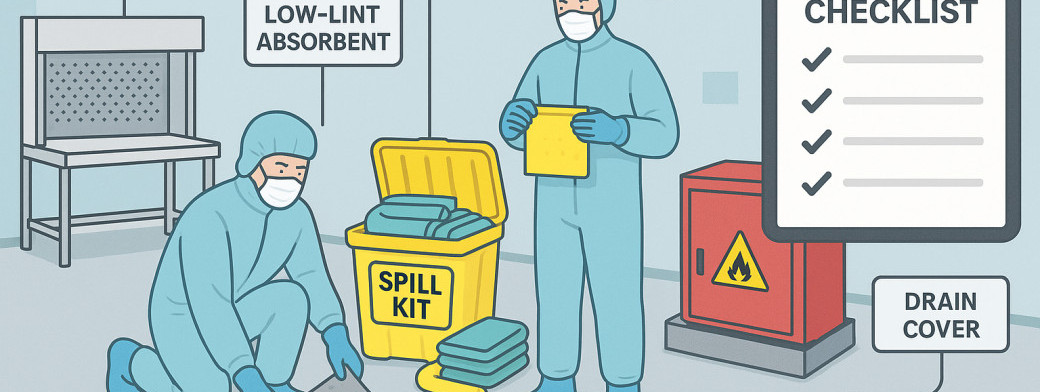
Spill Control in Pharmaceutical Manufacturing: Cleanroom-Compatible Solutions
Why Spill Control Matters in Pharmaceutical Manufacturing
Effective spill control is crucial in pharmaceutical manufacturing. It protects product integrity, ensures GMP compliance, enhances worker safety, prevents contamination, and reduces downtime. Spills can lead to significant operational disruptions and compliance issues, necessitating robust spill management strategies.
Regulatory Backdrop
In the UK, pharmaceutical manufacturers are governed by several regulatory frameworks. The MHRA Good Manufacturing Practice (GMP) outlines standards for quality management in production. Adhering to these guidelines is essential for maintaining product quality and ensuring patient safety.
The HSE COSHH regulations further mandate safe handling and storage of hazardous substances, which includes appropriate spill control measures. Compliance with these regulations not only mitigates risks but also supports audit readiness for GMP inspections.
Moreover, the Environment Agency’s industrial pollution prevention guidance highlights the need for effective spill management to protect the environment from chemical hazards.
Hazard Mapping
Identifying potential spill hazards is a critical step in spill management. Common pharmaceutical liquids include:
- Solvents
- Cleaning agents
- Buffers
- Acids and alkalis
- Water for Injection (WFI) leaks
- Oils in HVAC/plant systems
High-risk zones where spills are more likely to occur include:
- API production areas
- Formulation suites
- Cleanrooms
- Packaging halls
- Warehouses
- Utilities areas
Controls
Implementing appropriate controls is vital for effective spill management:
- Use lint-free, low-shedding absorbents that are compatible with cleanroom environments.
- Consider plant-based fibre absorbents for sustainable practices.
- Ensure bunded storage for solvents and flammable materials to contain leaks.
- Equip work areas with chemical spill kits specifically designed for acids and alkalis.
- Utilise earthing and anti-static absorbents in areas where flammable solvents are present.
- Incorporate drip trays under reactors, pumps, and WFI skids to capture leaks.
- Install drain protection mats or seals in vulnerable areas.
- Implement clear signage and segregation to minimise spill risks.
Kit Strategy
Having the right spill kits on hand is essential for quick response:
- Recommended kits for cleanrooms should include chemical spill kits, lint-free absorbent pads, and bunded storage solutions.
- Select kits based on the specific liquids handled in each area.
- Establish a routine for restocking kits and checking expiry dates.
- Implement tamper seals to maintain kit integrity.
- Strategically place kits in high-risk zones for immediate access.
Procedures & Training
Establishing clear procedures and training is vital for effective spill response:
- Create Standard Operating Procedures (SOPs) for spills within GMP environments, including steps for quarantine, isolation, containment, cleaning, and documentation.
- Specify appropriate Personal Protective Equipment (PPE) for different types of spills, particularly solvents, acids, and cytotoxics.
- Conduct toolbox talks and drills to ensure staff are familiar with spill response protocols.
- Encourage near-miss reporting to identify and mitigate potential spill risks.
- Provide induction training for contractors and agency staff on spill management practices.
Waste & Evidence
Proper disposal of contaminated absorbents is critical for compliance:
- Dispose of absorbents contaminated with solvents or active ingredients as hazardous waste.
- Ensure segregation of clinical and pharmaceutical waste from general waste.
- Store hazardous waste in UN-approved containers to meet legal requirements.
- Maintain duty-of-care paperwork to demonstrate compliance with waste regulations.
- Link spill documentation to MHRA data integrity requirements to support audit trails.
Practical Tools
Utilise the following practical tools for spill response:
- One-page GMP-compliant spill response checklist for quick reference.
- Response flow for:
- Flammable solvent spill: Evacuate area, activate alarm, use appropriate absorbents, and document.
- Corrosive acid/alkali spill: Isolate spill, use neutralising agents, contain and clean, document actions taken.
- Buffer/media spill in cleanroom: Isolate area, use lint-free absorbents, clean thoroughly, document incident.
Mini Case Vignette
Consider a recent incident involving an ethanol spill in a formulation suite:
The root cause was identified as a failed seal on a storage container. Immediate response actions included:
- Evacuating the area and notifying the EHS manager.
- Using appropriate absorbents to contain the spill.
- Documenting the incident and the response actions taken.
- Reviewing procedures to prevent future occurrences.
As a result, audit-ready documentation was generated, demonstrating compliance with regulatory standards.
FAQs
- What absorbents are GMP cleanroom compatible? Lint-free, low-shedding absorbents are essential for maintaining cleanroom standards.
- Are plant-based fibres suitable for pharma? Yes, they offer sustainable options while effectively managing spills.
- Can oil-only pads be used in solvent areas? No, ensure that absorbents are suitable for the specific hazards present.
- How to document spills for MHRA audits? Maintain detailed records of the incident, response actions, and any corrective measures taken.
- How often to check spill kits? Regular checks should be conducted quarterly, or after any use, to ensure readiness.
- How to segregate spill waste in GMP? Ensure hazardous waste is stored separately in UN-approved containers and documented appropriately.
Conclusion
Effective spill control in pharmaceutical manufacturing is essential for compliance, safety, and operational efficiency. By implementing cleanroom-compatible solutions and following best practices, your facility can mitigate spill risks and maintain high standards of product integrity. For comprehensive spill management products, explore SERPRO’s UK range, including chemical spill kits and bunded storage solutions.
